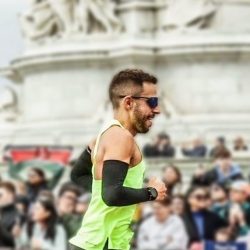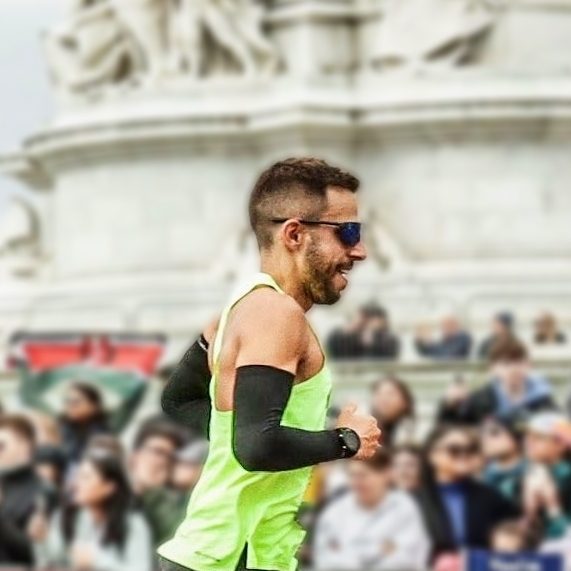Our verdict
- Top pick in best barefoot running shoes
- Top pick in best zero drop running shoes
Pros
- Low price
- Super-flexible and comfortable
- Rugged toebox for daily wear
- Thick outsole with full-rubber coverage
- Snug but spacious fit
- Adjustable tension strap system
- Perforated insole
Cons
- Warm upper lacks airflow
- Heavier than it should be!
- Terrible grip
Audience verdict
- Top 8% in road running shoes
- Top 20% in Xero Shoes
Comparison
The most similar running shoes compared
+ + Add a shoe | |||||
|---|---|---|---|---|---|
| Audience score | 91 Superb! | 85 Good! | 82 Good! | 86 Good! | |
| Price | $90 | $120 | $115 | $90 | |
| Pace | Daily running | Daily running | Daily running | Daily running | |
| Shock absorption | Low | - | Low | Low | |
| Energy return | Low | - | Low | Low | |
| Traction | Moderate | - | High | - | |
| Arch support | Neutral | Neutral | Neutral | Neutral | |
| Weight lab Weight brand | 9.8 oz / 279g 7.4 oz / 210g | 8.6 oz / 244g 8.3 oz / 235g | 6.8 oz / 193g 6.6 oz / 187g | 5.6 oz / 159g 5.3 oz / 150g | |
| Lightweight | ✗ | ✓ | ✓ | ✓ | |
| Drop lab Drop brand | 0.4 mm 0.0 mm | 1.0 mm 0.0 mm | -0.2 mm 0.0 mm | 0.0 mm 0.0 mm | |
| Strike pattern | Mid/forefoot | Mid/forefoot | Mid/forefoot | Mid/forefoot | |
| Size | True to size | True to size | - | True to size | |
| Midsole softness | - | Firm | Balanced | - | |
| Difference in midsole softness in cold | - | Small | Normal | - | |
| Toebox durability | Good | Decent | Good | Decent | |
| Heel padding durability | Bad | Bad | Good | Decent | |
| Outsole durability | Decent | Decent | Good | Decent | |
| Breathability | Warm | Breathable | Moderate | Moderate | |
| Width / fit | Medium | Narrow | Medium | Medium | |
| Toebox width | Wide | Wide | Wide | Wide | |
| Stiffness | Flexible | Moderate | Flexible | Flexible | |
| Torsional rigidity | Flexible | Flexible | Flexible | Flexible | |
| Heel counter stiffness | Flexible | Moderate | Flexible | Flexible | |
| Heel lab Heel brand | 12.2 mm 7.0 mm | 13.1 mm 12.0 mm | 13.7 mm 14.0 mm | 7.6 mm 6.0 mm | |
| Forefoot lab Forefoot brand | 11.8 mm 7.0 mm | 12.1 mm 12.0 mm | 13.9 mm 14.0 mm | 7.6 mm 6.0 mm | |
| Widths available | NormalWide | NormalWide | NormalWide | Normal | |
| Orthotic friendly | ✓ | ✓ | ✓ | ✗ | |
| Season | All seasons | SummerAll seasons | All seasons | All seasons | |
| Removable insole | ✓ | ✓ | ✓ | ✗ | |
| Ranking | #23 Top 7% | #207 Bottom 44% | #288 Bottom 23% | #177 Top 48% | |
| Popularity | #240 Bottom 36% | #292 Bottom 22% | #300 Bottom 20% | #185 Top 50% |
Who should buy
We found that the Xero Shoes Prio is ideal for:
- Those who want a minimalist running shoe that stays budget-friendly without skipping comfort.
- Anyone looking for a barefoot-style option for everyday tasks like walking or working—plus some occasional running—with extra adjustability from the wraparound tension straps.
- Newcomers to minimalist footwear seeking a decently-priced shoe to test the waters without a big commitment.
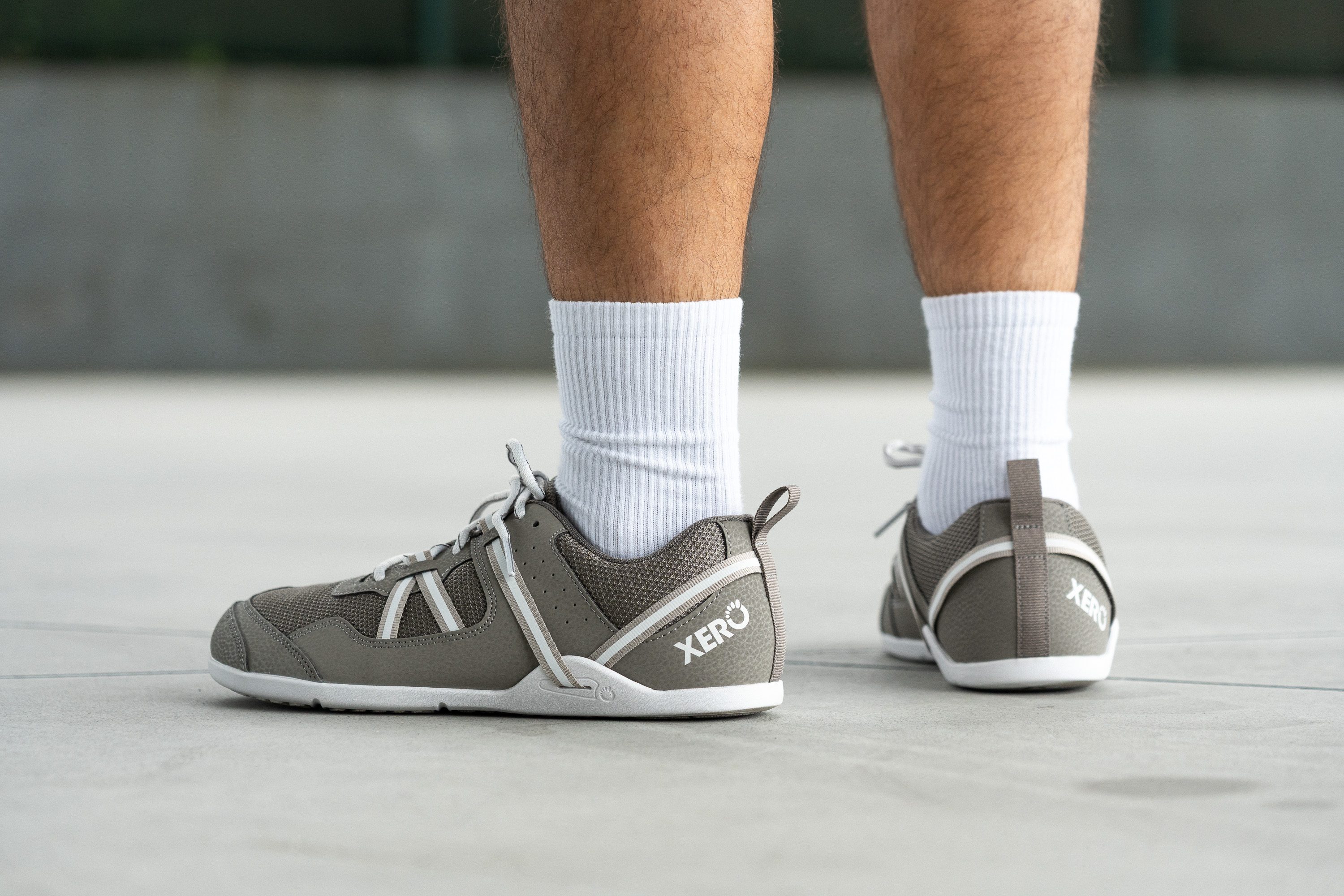
Who should NOT buy
We found that breathability is one of the biggest letdowns in this shoe. Its upper fails to deliver airflow in warm conditions. For a breathable alternative, we suggest the Xero Shoes HFS II—it shares the same barefoot-minded design but scored much higher in our lab’s airflow test.
Additionally, we think grip is a real concern here. This shoe simply performs below average, particularly on wet surfaces. If traction matters to you, we suggest the Altra Escalante 4 instead—just remove the insole for a closer-to-the-ground, minimalist-inspired ride.

Cushioning
Shock absorption
We tested the shoe in our lab and confirmed it's a truly low-to-the-ground design. With just 25 SA in shock absorption, it ranks as one of the most minimalist models we’ve analyzed.
Instead of plush, foam-loaded comfort, this back-to-basics shoe delivers a road-connected feel that it's 100% perfect for runners chasing a muscle-activating experience.
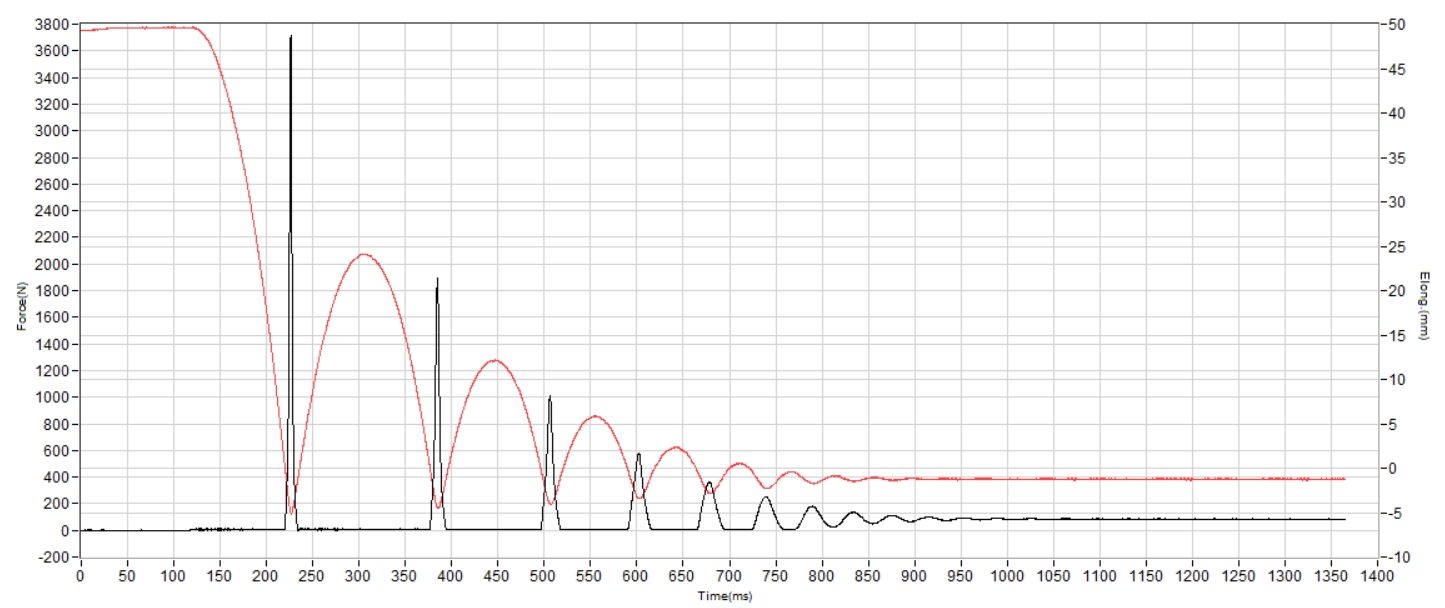
| Prio | 25 SA |
| Average | 129 SA |
Energy return
Despite its minimalist design and ultra-thin midsole, the Prio delivers solid energy return at 52.2%.
| Prio | 52.2% |
| Average | 58.5% |
Heel stack
The Xero Shoes Prio features an ultra-thin stack height just over a centimeter. Our digital calipers measured a precise 12.2 mm—offering a near-barefoot feel that keeps you closely connected to the surface beneath your feet.
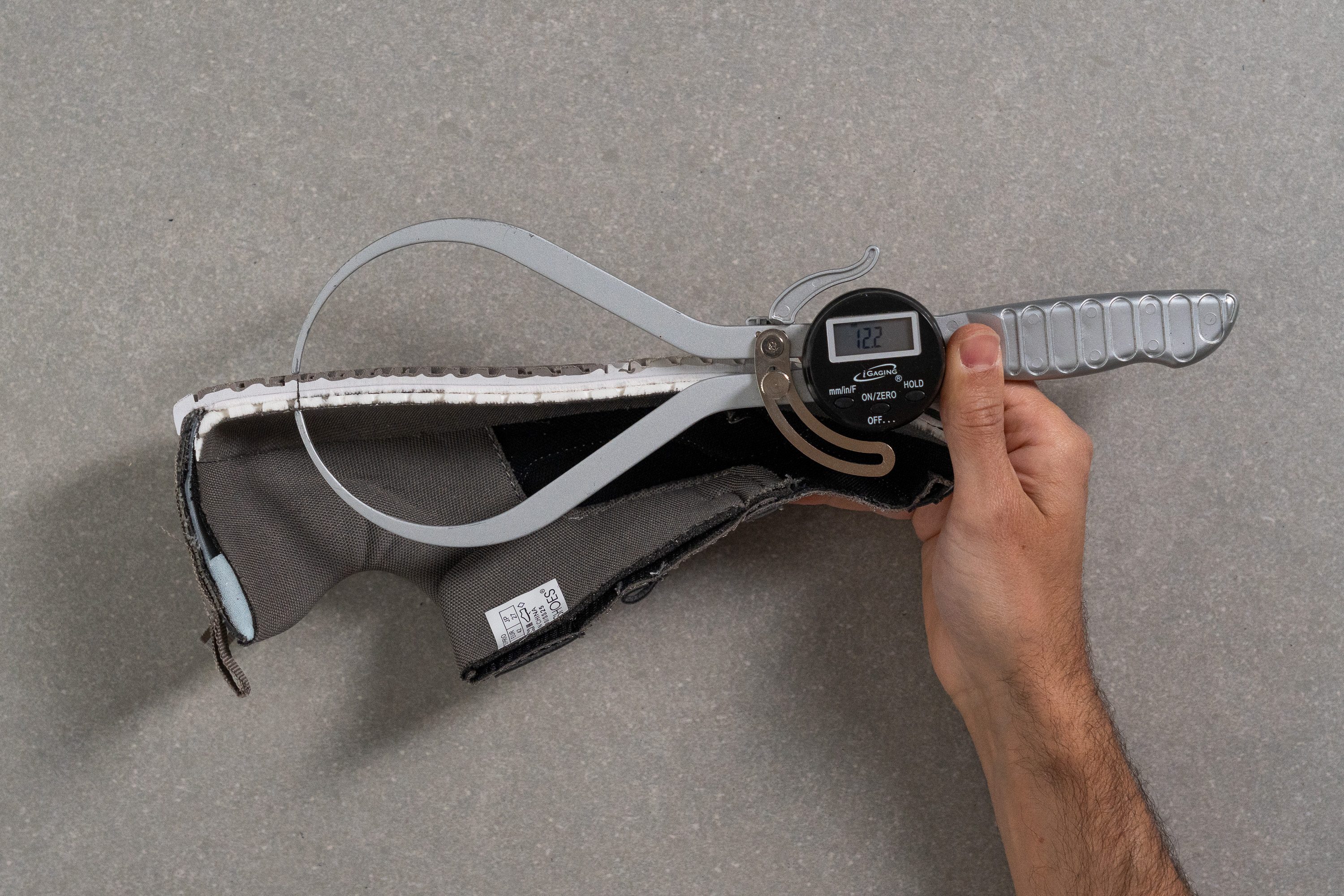
| Prio | 12.2 mm |
| Average | 34.8 mm |
Forefoot stack
The forefoot keeps that close-to-the-ground vibe with a slightly lower stack of 11.8 mm.
And it feels exactly as it appears—far less cushioned than the average running shoe but offering a touch more protection than a full-barefoot design.
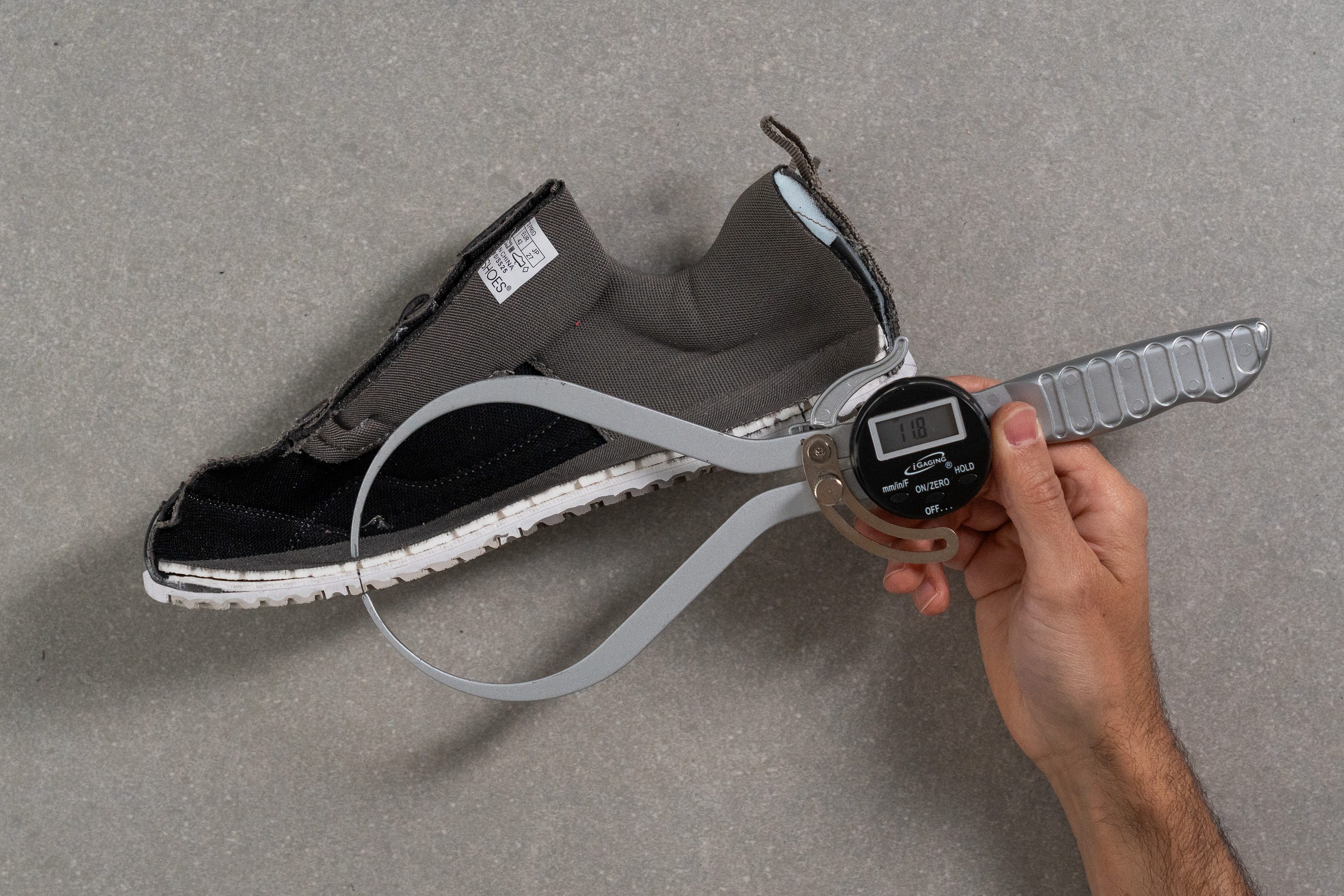
| Prio | 11.8 mm |
| Average | 26.2 mm |
Drop
Xero Shoes markets the Prio as a zero-drop shoe, and after running our precise measurements, we can confirm it lives up to the claim. While we found a real 0.4 mm drop, that’s comfortably within standard manufacturing tolerances.
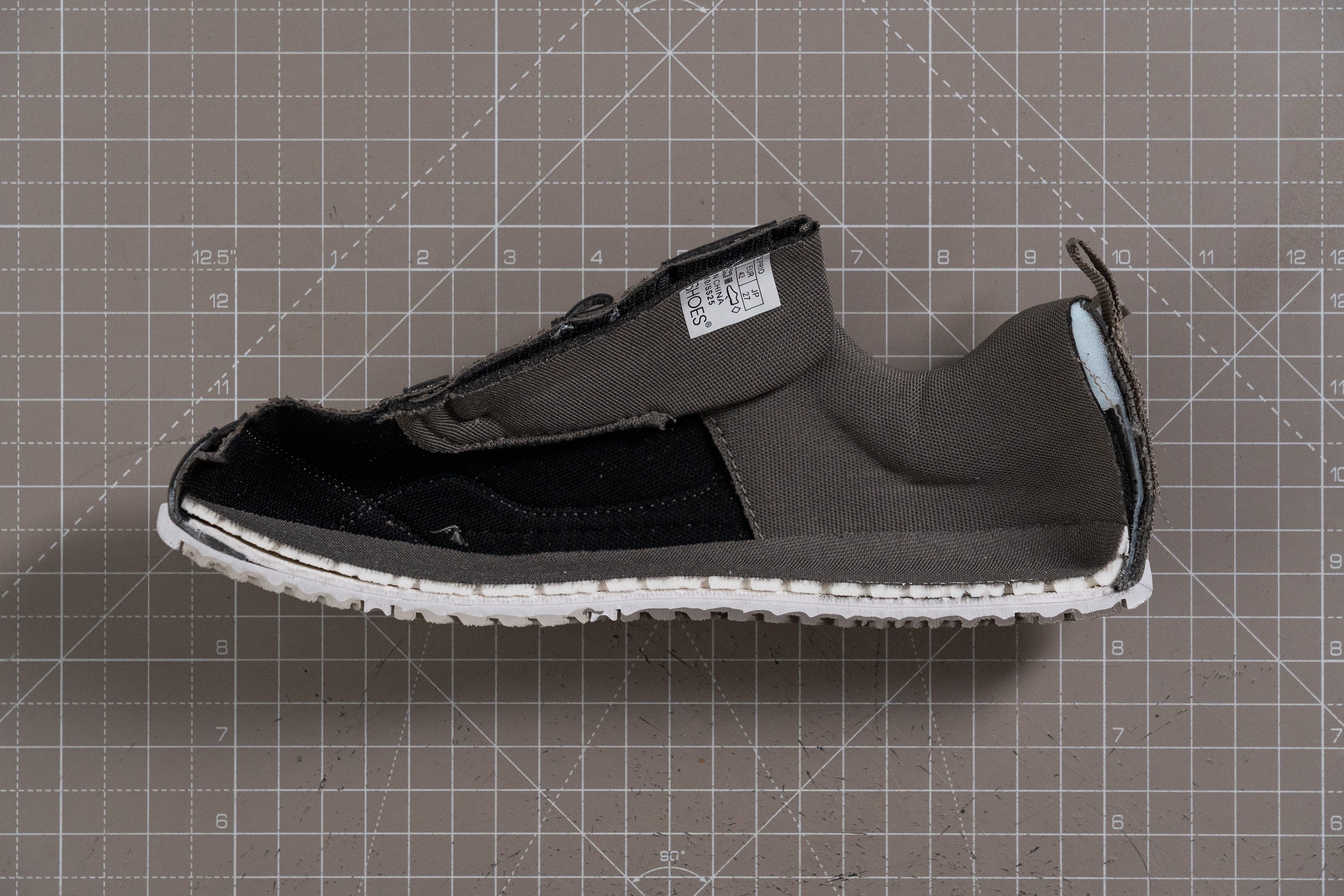
| Prio | 0.4 mm |
| Average | 8.6 mm |
Rocker
As expected, the rocker is virtually nonexistent, with zero heel curvature. That's no surprise, since heel striking in a shoe like this isn’t recommended.
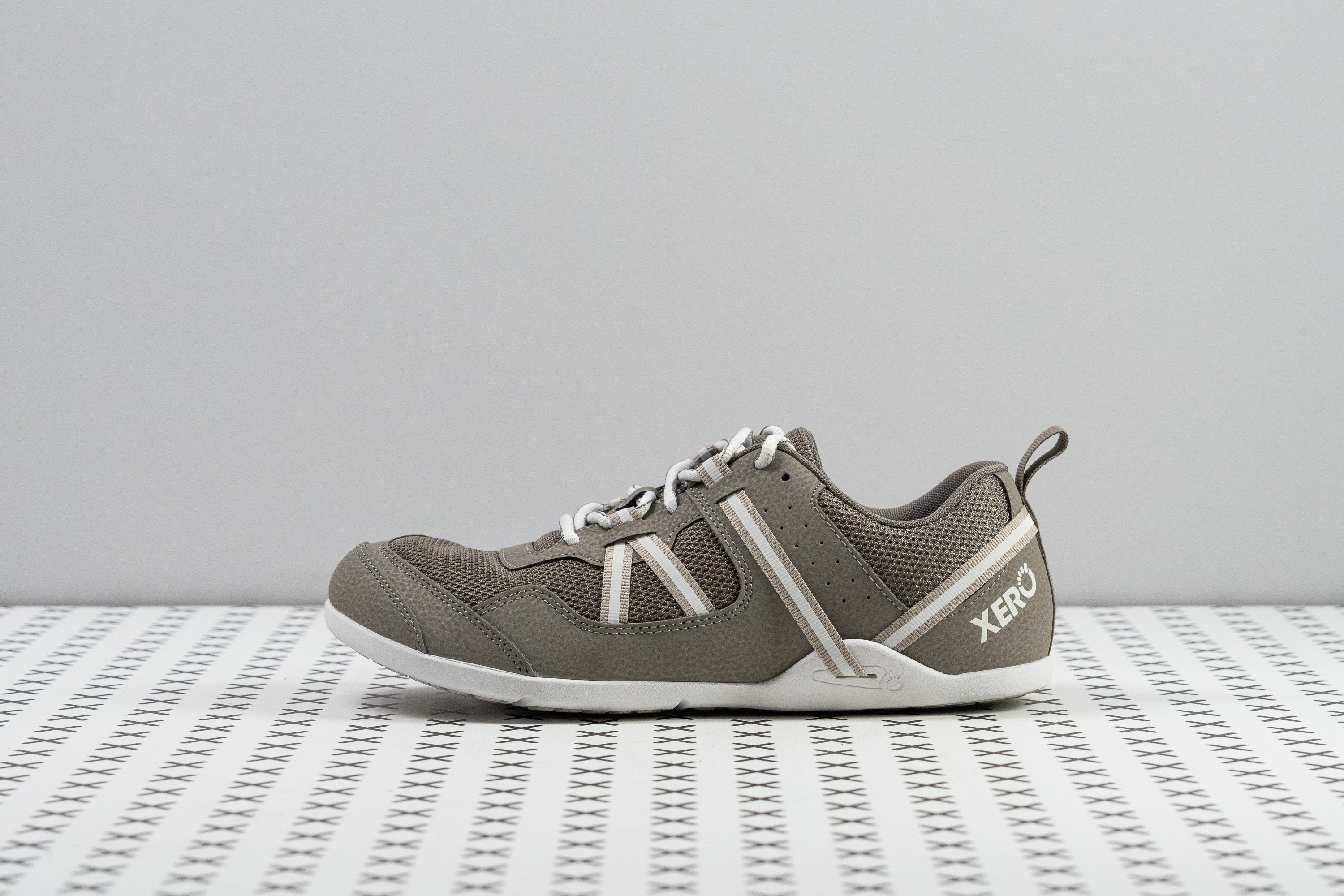
Up front, there’s a mild toe spring that slightly assists transitions, though it’s so subtle you’ll hardly notice it’s there.
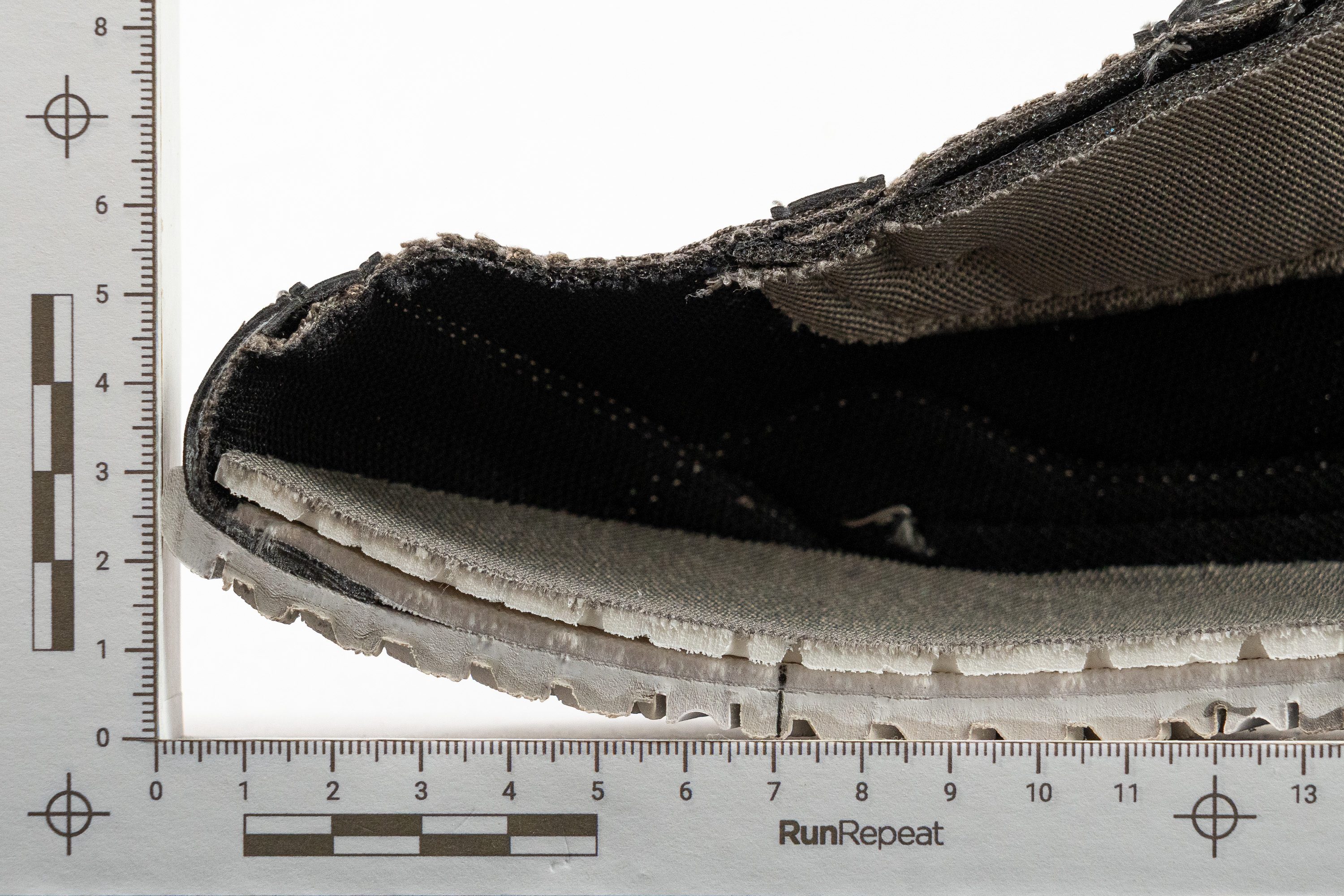
Size and fit
Size
Xero Shoes Prio fits true to size (352 votes).
Width / Fit
Most minimalist shoes come with extra-wide toeboxes that feel amazing for broad-footed runners, but the Prio doesn't feel like that at all—though it still offers more space than the average daily trainer.
We discovered this during testing, as our first measurement came in slightly below average, explaining the snugger-than-expected fit.

| Prio | 94.1 mm |
| Average | 95.1 mm |
Toebox width
Our second measurement in the big toe area was more generous, reaching 76.2 mm.
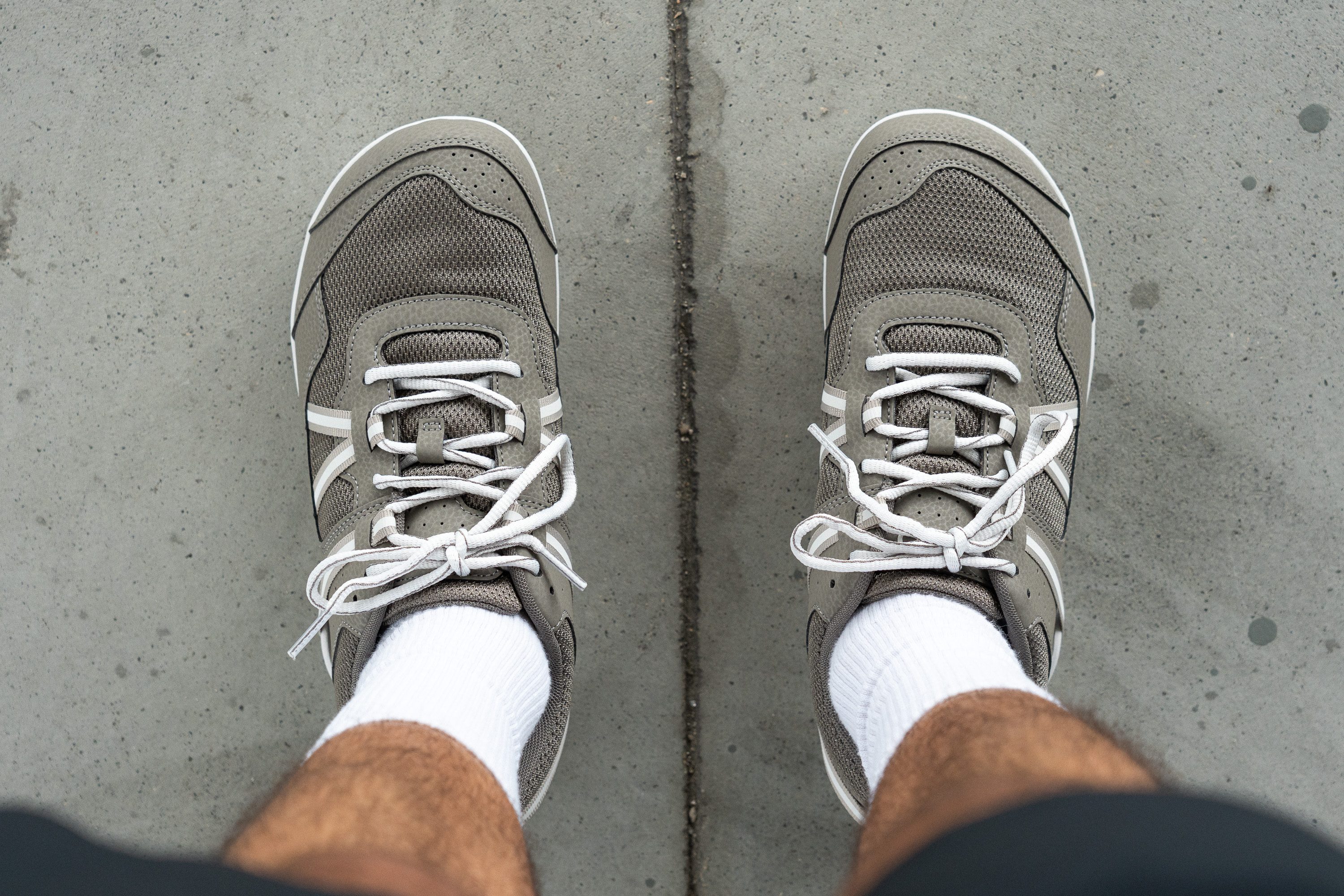
We found that it allows more natural toe splay than most running shoes, landing somewhere in the middle-ground category between those and foot-shaped shoes.
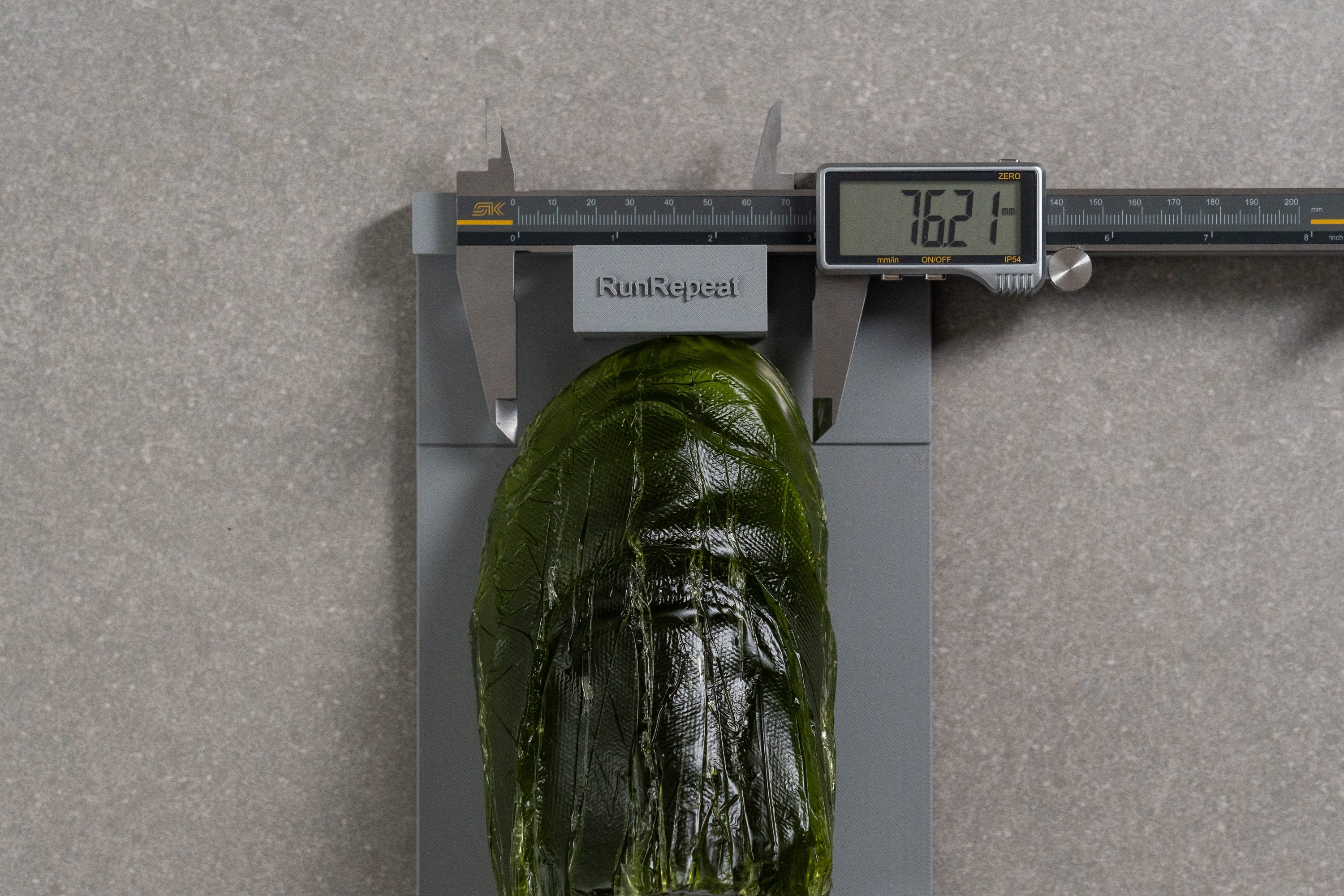
| Prio | 76.2 mm |
| Average | 73.2 mm |
Toebox height
Our third measurement switched to height, and the Prio reached the top tier with 33.9 mm of vertical clearance.
This sky-high toebox adds comfort especially for bulky toes, though it might feel loose or floppy for those seeking a snugger fit.
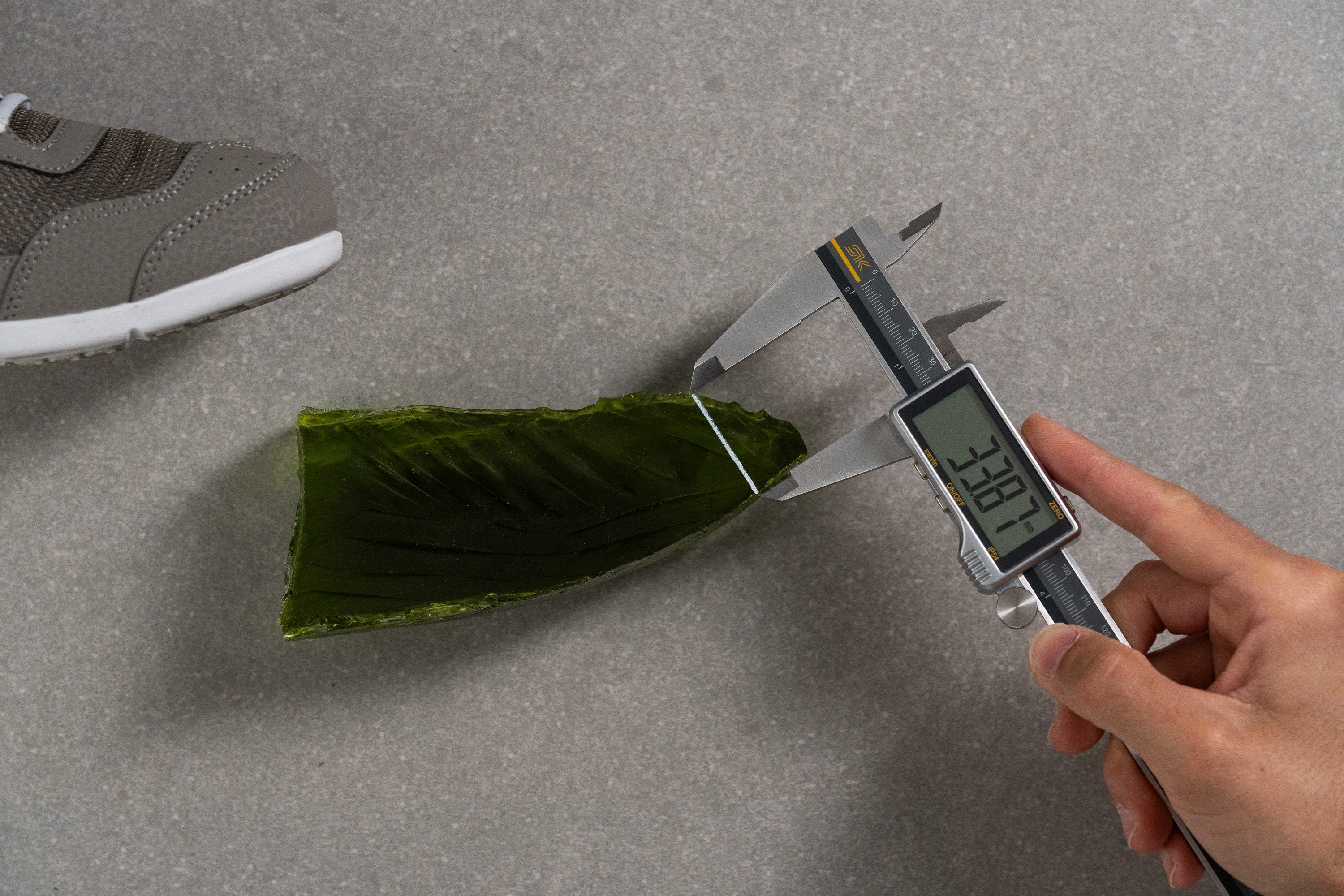
| Prio | 33.9 mm |
| Average | 27.1 mm |
Traction / Grip
Traction test
The Prio falls short when it comes to grip. It scored only 0.27, which means traction is acceptable on dry ground—but once moisture comes into play, expect noticeable slippage underfoot.
| Prio | 0.27 |
| Average | 0.48 |
Outsole design
The Xero Shoes Prio features full-length rubber coverage with three segmented zones separated by deep flex grooves for added articulation. Each rubber segment showcases a uniform chevron-style tread pattern arranged in alternating directions. However, as we found in our grip test, it didn't work that well...
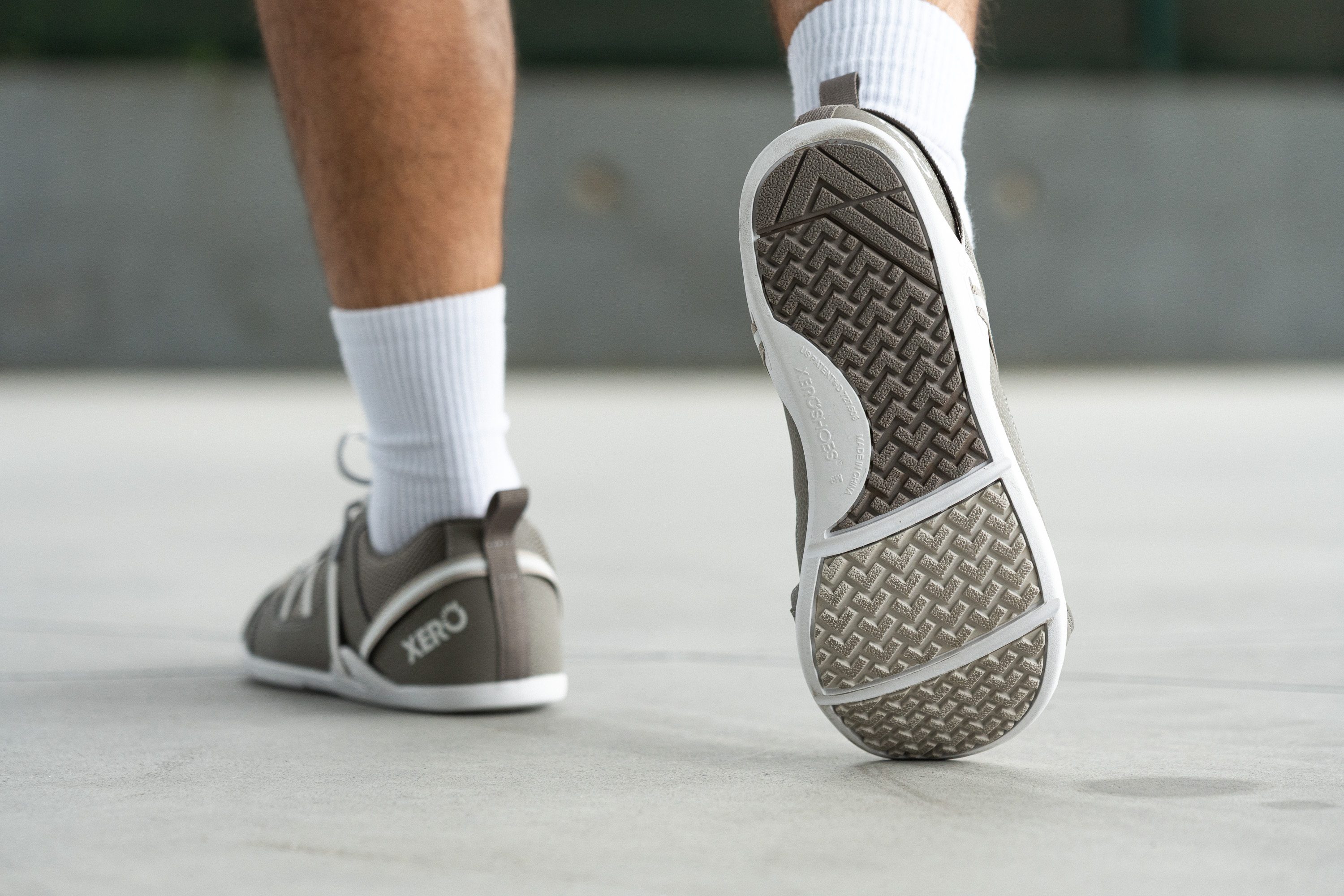
Flexibility / Stiffness
Any shoe aiming to be labeled as minimalist or barefoot needs to be ultra-bendable, period. That’s where we come in with our lab machines, testing shoes under a highly-controlled, repeatable setup.
And the Prio passed with flying colors. We tested it in our 30-degree bend assessment, and it needed just 4.0N. That's an impressively low score!

| Prio | 4.0N |
| Average | 15.3N |
Weight
While we were genuinely impressed with its feedback-rich ride and yoga-inspired flexibility, the weight came as a major letdown. We tested the Prio at 9.8 oz or 279g, far too much for a midsole-free design.
For context, the maximalist ASICS Superblast 2 weighs just 8.9 oz or 252g, even with over 40 mm of foam packed underfoot!
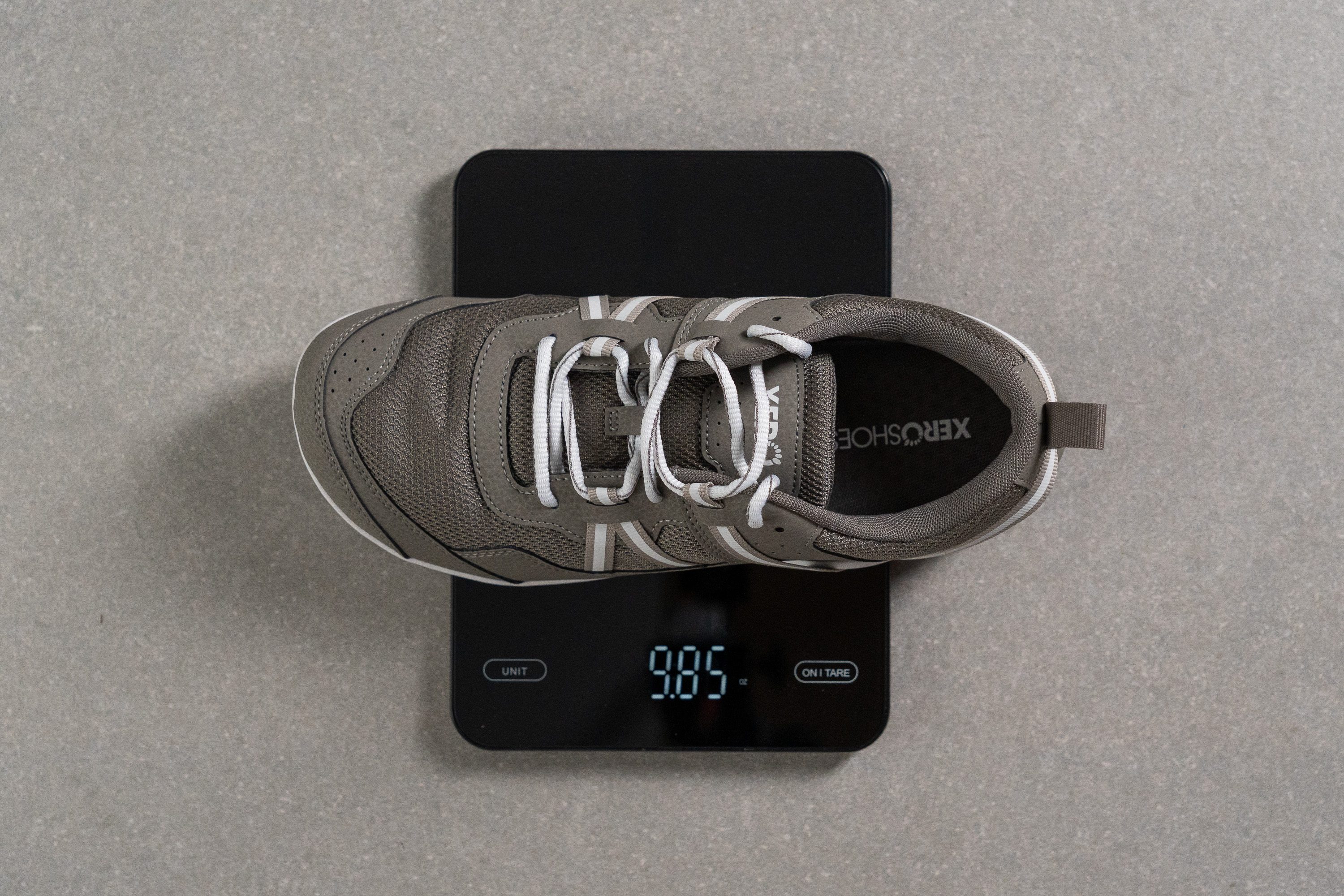
| Prio | 9.8 oz (279g) |
| Average | 9.3 oz (264g) |
Breathability
Upon close inspection of the Xero Shoes Prio under controlled lighting, we noticed right away how little light passed through the upper—indicating limited airflow. Our smoke test backed this up with a below-average 2/5 score.
We believe the main reason for this score is the multi-layered, thick upper. Xero uses a standard mesh base, but it’s paired with a durability-focused overlay that completely blocks airflow—ideal for cold climates but not for summer.
When we magnified the upper with our digital microscope, we saw that the mesh had no visible ventilation holes.

From our experience, this construction helps prevent wear and tear and we'll check that in a minute with our Dremel. However, runners in warmer areas may find it stuffy.
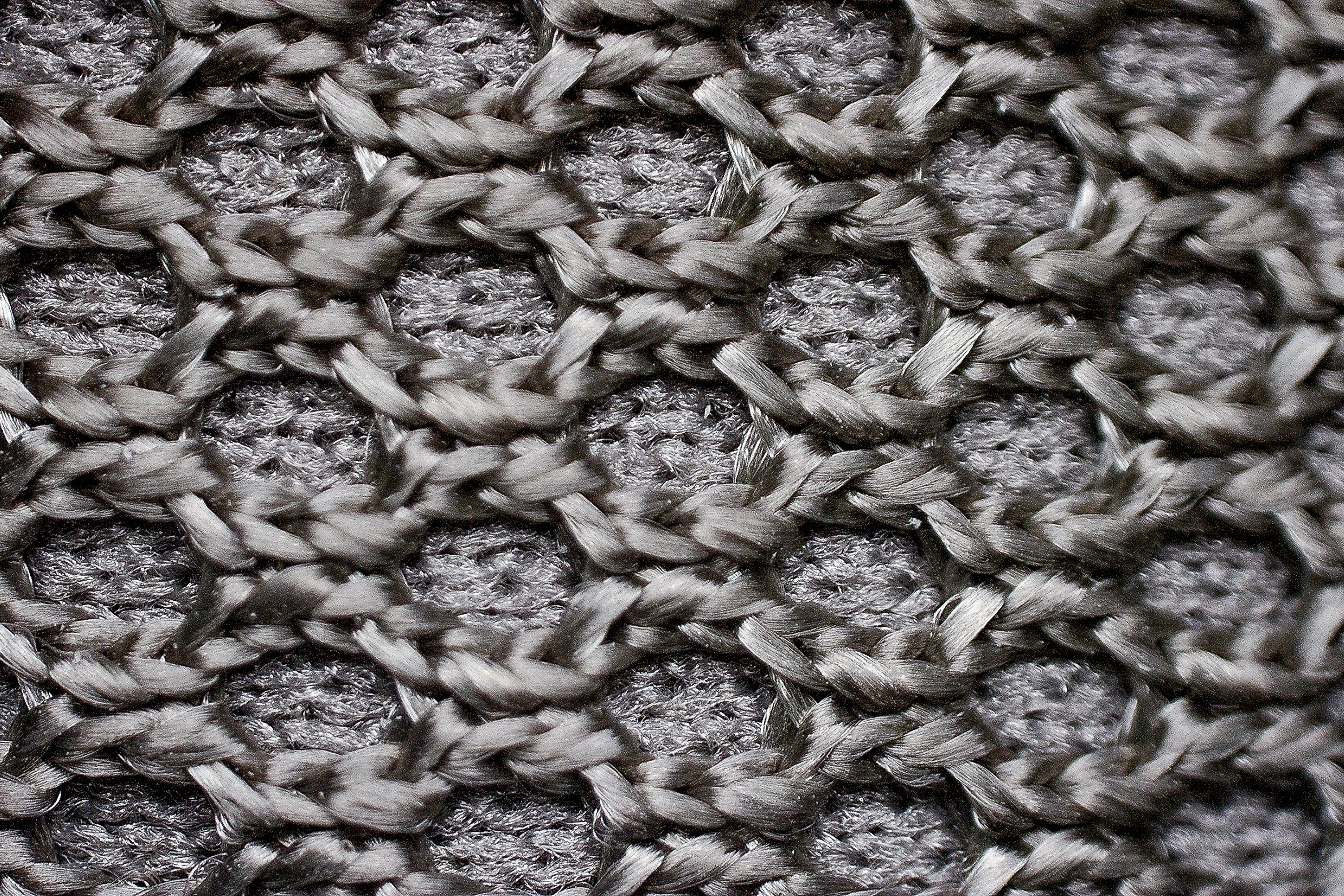
We also found that the heel and tongue are padded similarly to average daily trainers. This adds comfort but makes the shoe even less breathable overall.
| Prio | 2 |
| Average | 3.7 |
Stability
Lateral stability test
Compared to most running shoes, it's clear that this one drops you much closer to the ground, delivering a balance-boosting sensation. Even at faster paces, we found that the Prio maintains this stable, stripped-down ride.
Torsional rigidity
Without those extra 3 or 4 centimeters of thick foam underfoot, the Prio becomes ultra-bendable... and we’re here for it. Scoring just 1 out of 5, it delivers the barefoot-like flexibility we expect from minimalist shoes, encouraging full foot-and-ankle engagement.
| Prio | 1 |
| Average | 3.5 |
Heel counter stiffness
The heel counter has a bit of structure, so it’s not completely flexible. Still, with a 2/5 score, it offers a decently adaptive feel that molds to your foot without being too stiff.
| Prio | 2 |
| Average | 2.9 |
Midsole width - forefoot
Staying true to its minimalist DNA, the midsole has slimmer proportions than nearly any shoe you’ll spot on fellow runners. We measured just 105.6 mm in the forefoot, which is undeniably compact!
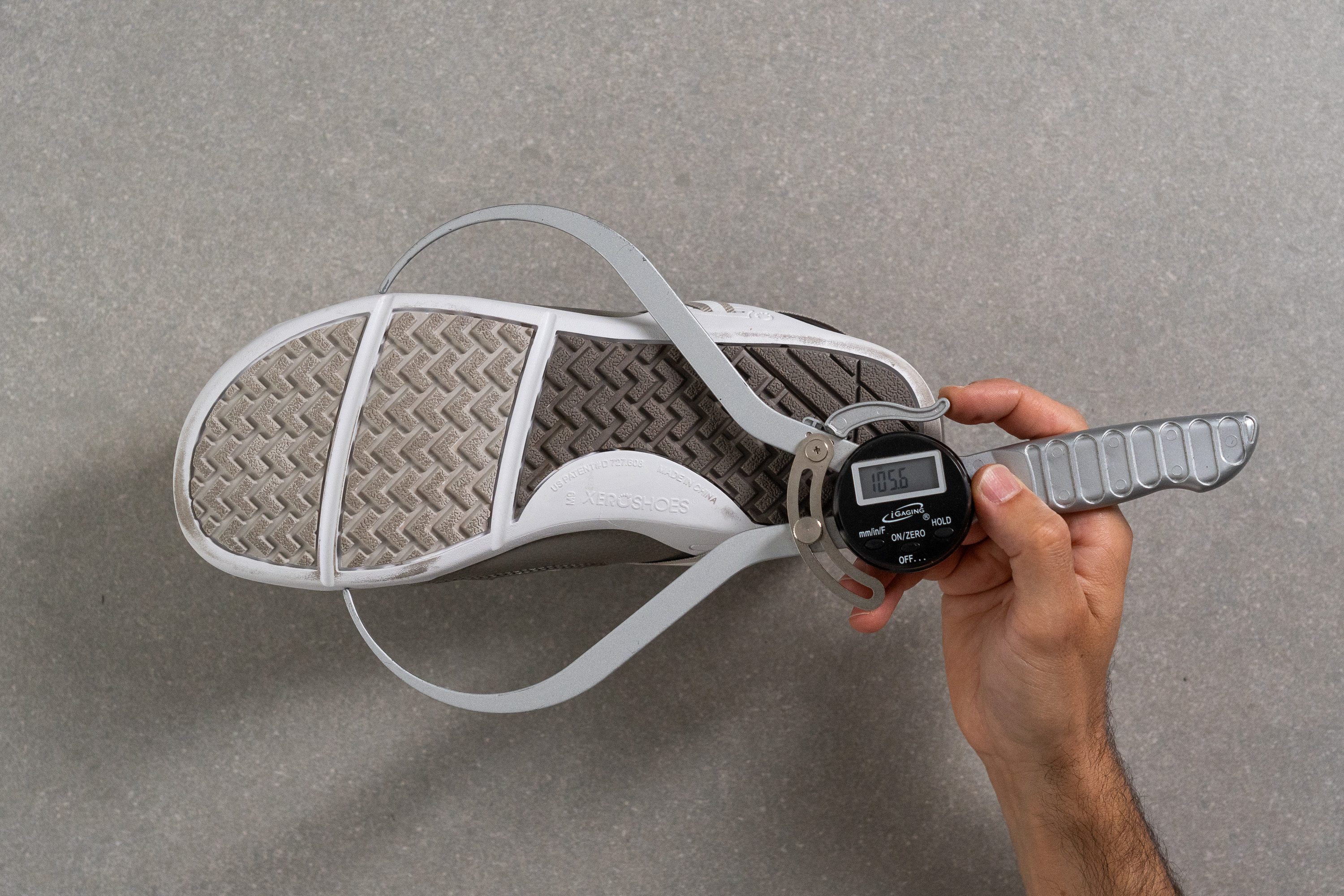
| Prio | 105.6 mm |
| Average | 114.4 mm |
Midsole width - heel
The heel is even more minimal, coming in at just 78.3 mm. This ultra-slim rearfoot design clearly discourages any kind of heel striking during runs!
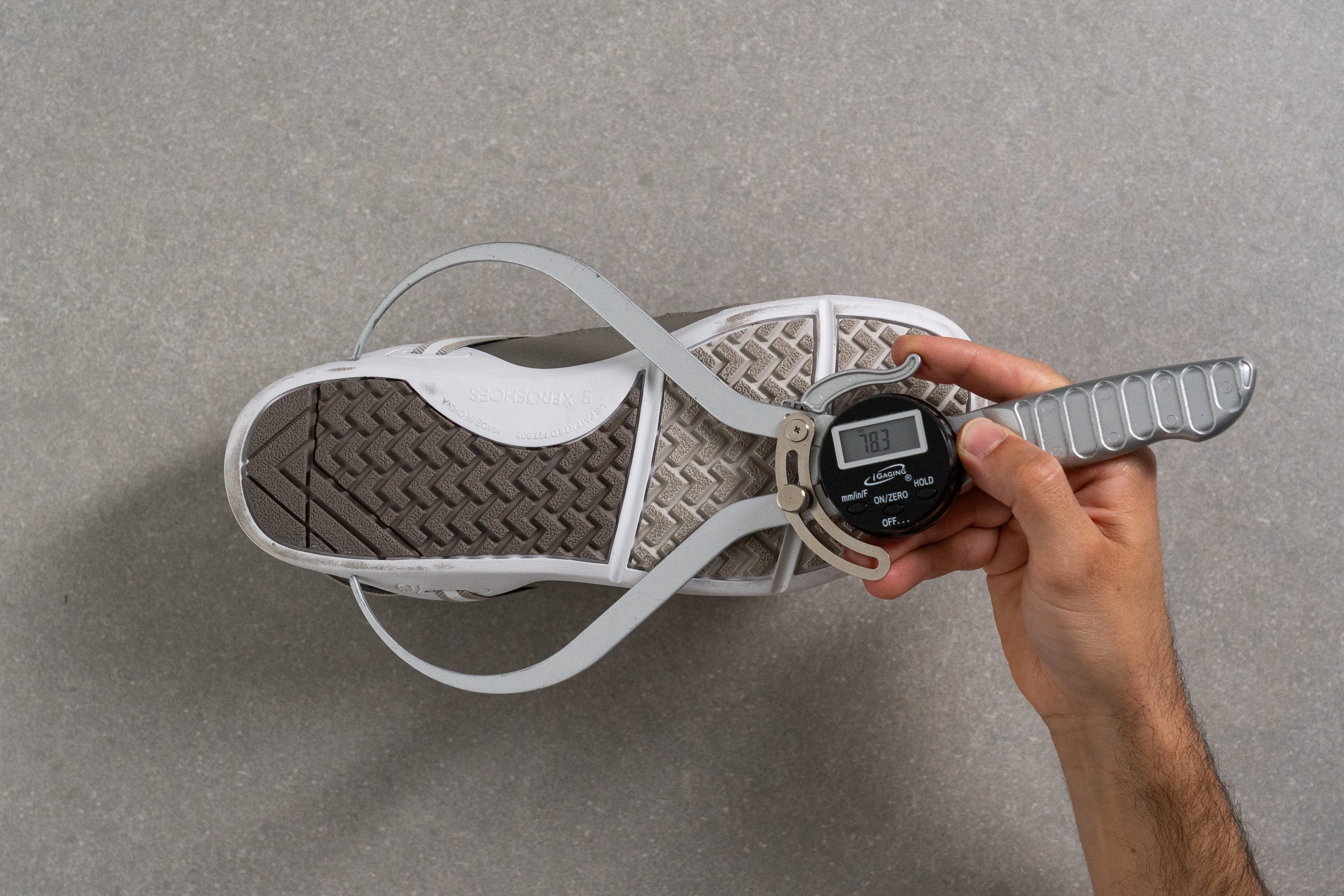
| Prio | 78.3 mm |
| Average | 90.7 mm |
Durability
Toebox durability
As we expected, the toebox delivered a strong performance in our durability test, scoring 4 out of 5.
| Prio | 4 |
| Average | 2.6 |
Heel padding durability
However, the heel padding performed poorly in our Dremel test. While everyday use won’t stress it like our tool does, you should know that it’s not the most impressive out there with its 1-out-of-5 score.
| Prio | 1 |
| Average | 3.4 |
Outsole durability
The outsole held up well, landing right around the average. We measured just 1.0 mm of wear using a tire tread gauge—a result that left us satisfied too.
| Prio | 1.0 mm |
| Average | 1.1 mm |
Outsole thickness
This shoe packs a massive 6.1-mm outsole—which is pretty mind-blowing.
In fact, this ultra-thick rubber is the main reason behind its excessive weight, and we believe trimming it while adding a thicker insole (or even a super-slim midsole!) would’ve been a smart move for v2.
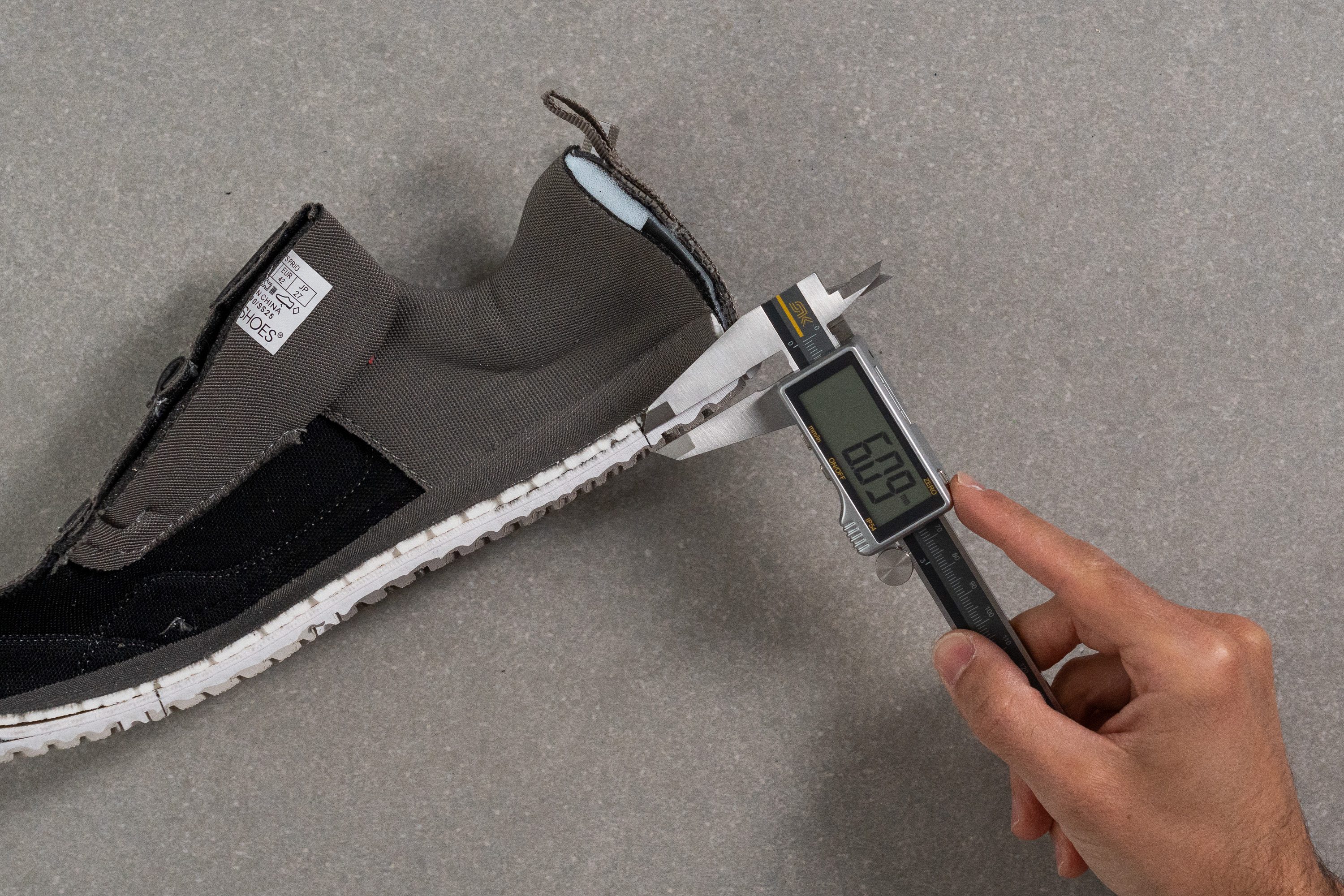
| Prio | 6.1 mm |
| Average | 3.2 mm |
Misc
Insole thickness
The Xero Shoes Prio skips a traditional midsole, relying instead on a 3.6-mm insole and the outsole to provide its minimalist cushioning system.

| Prio | 3.6 mm |
| Average | 4.5 mm |
Removable insole
We discovered that the insole is fully removable and features multiple perforations. That's a smart, airflow-boosting detail meant to offset the shoe’s limited ventilation.
There’s also generous vertical clearance inside as we found before, so if you're after more cushioning, simply swap in a plush insole like the one from the Saucony Ride 18.
| Prio | Yes |
Reflective elements
We found that Xero Shoes added a visibility-boosting twist by making the adjustable straps reflective.
| Prio | Yes |
Tongue padding
One of the standout elements in some Xero Shoes is the use of tension straps, giving runners total control over lockdown. They’re cleverly built into the lacing system and wrap around the shoe for adjustable support.
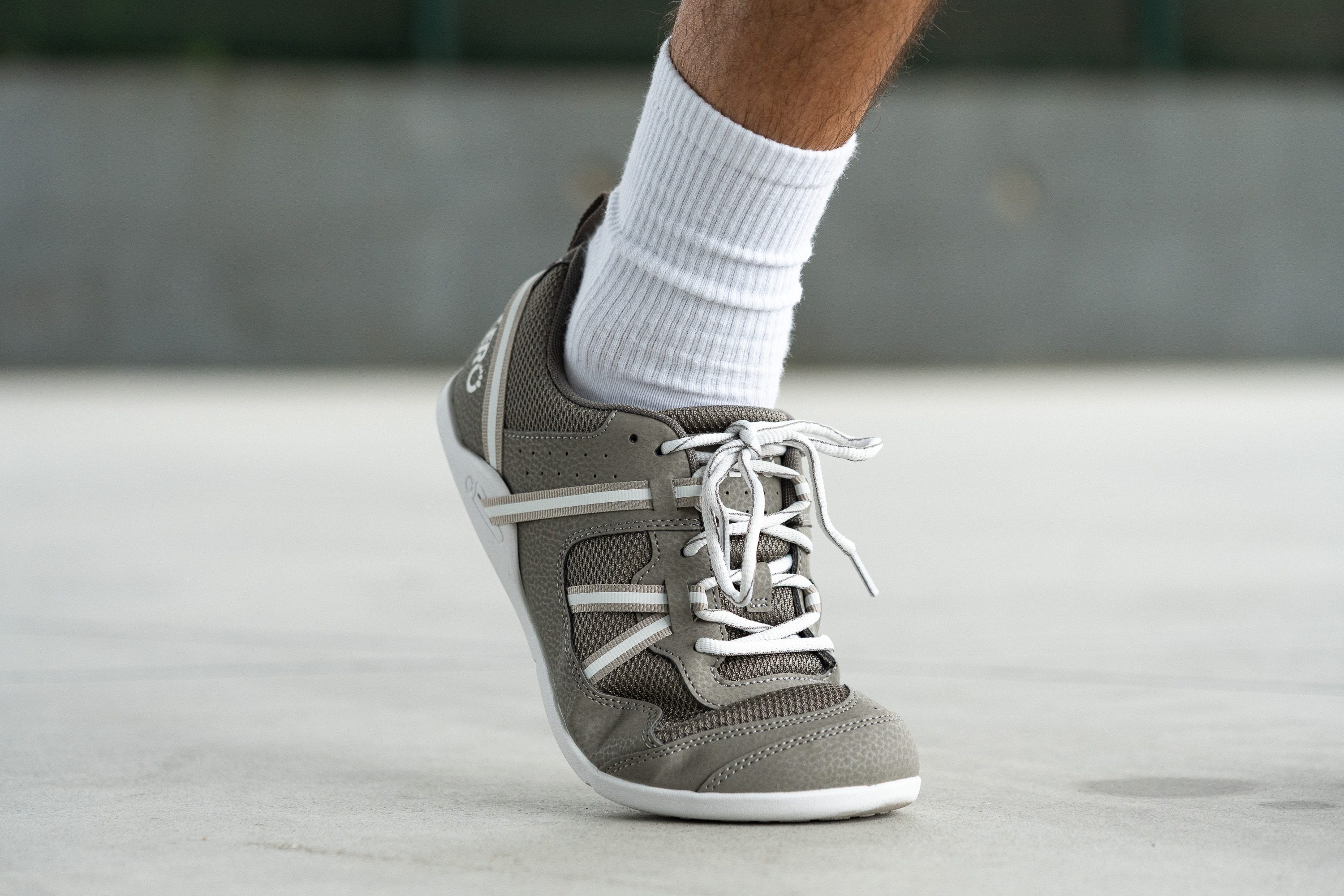
As for the tongue, we discovered a 6.9-mm thick design that leans heavily toward comfort. That might feel a bit too plush for a minimalist shoe, but those who enjoy pillow-soft tongues will likely appreciate this setup.
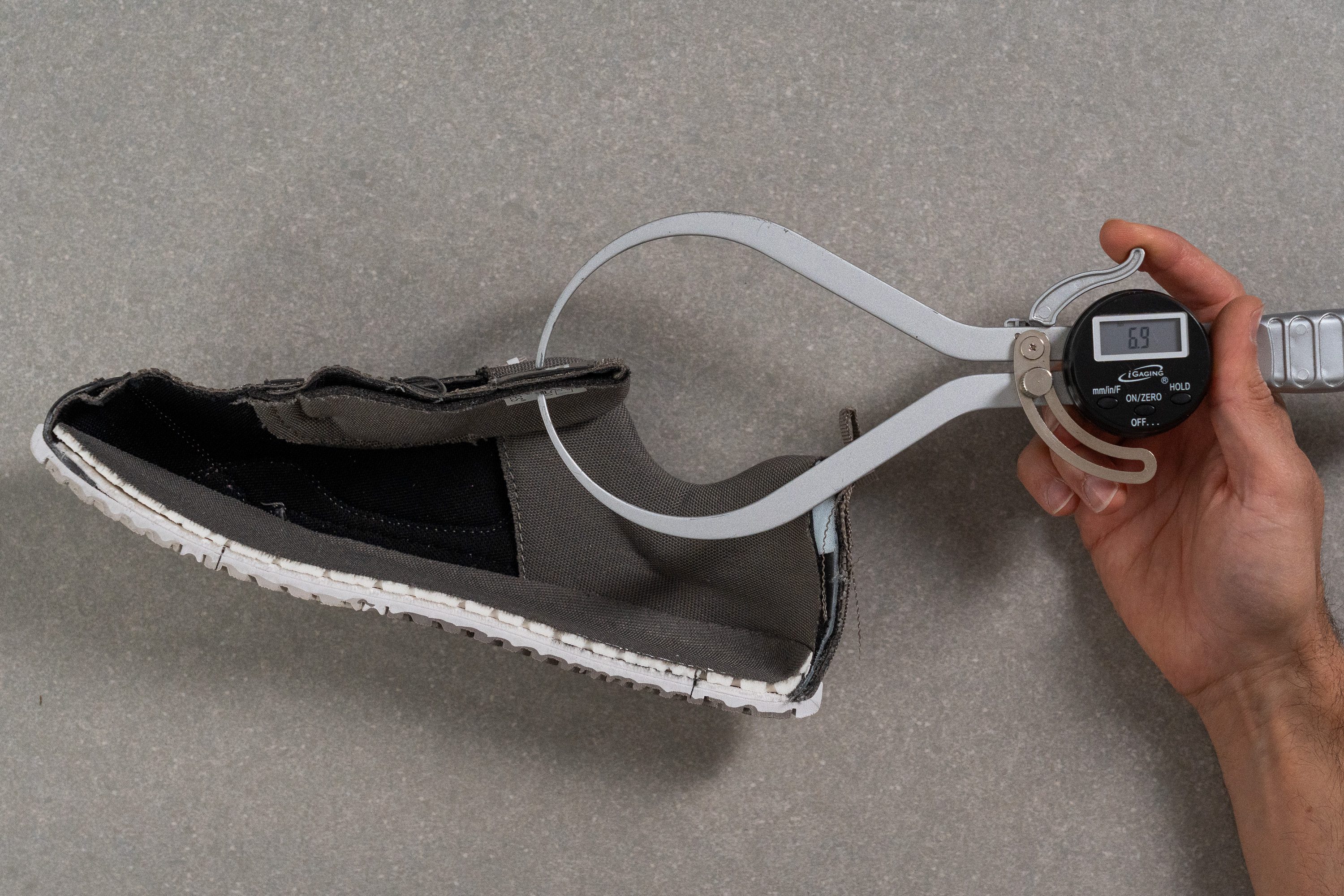
| Prio | 6.9 mm |
| Average | 5.8 mm |
Tongue: gusset type
The tongue is ungusseted—something expected in a wallet-friendly shoe like the Prio. While we don’t see it as a major issue, having it attached to the sides would've offered a more secure feel.
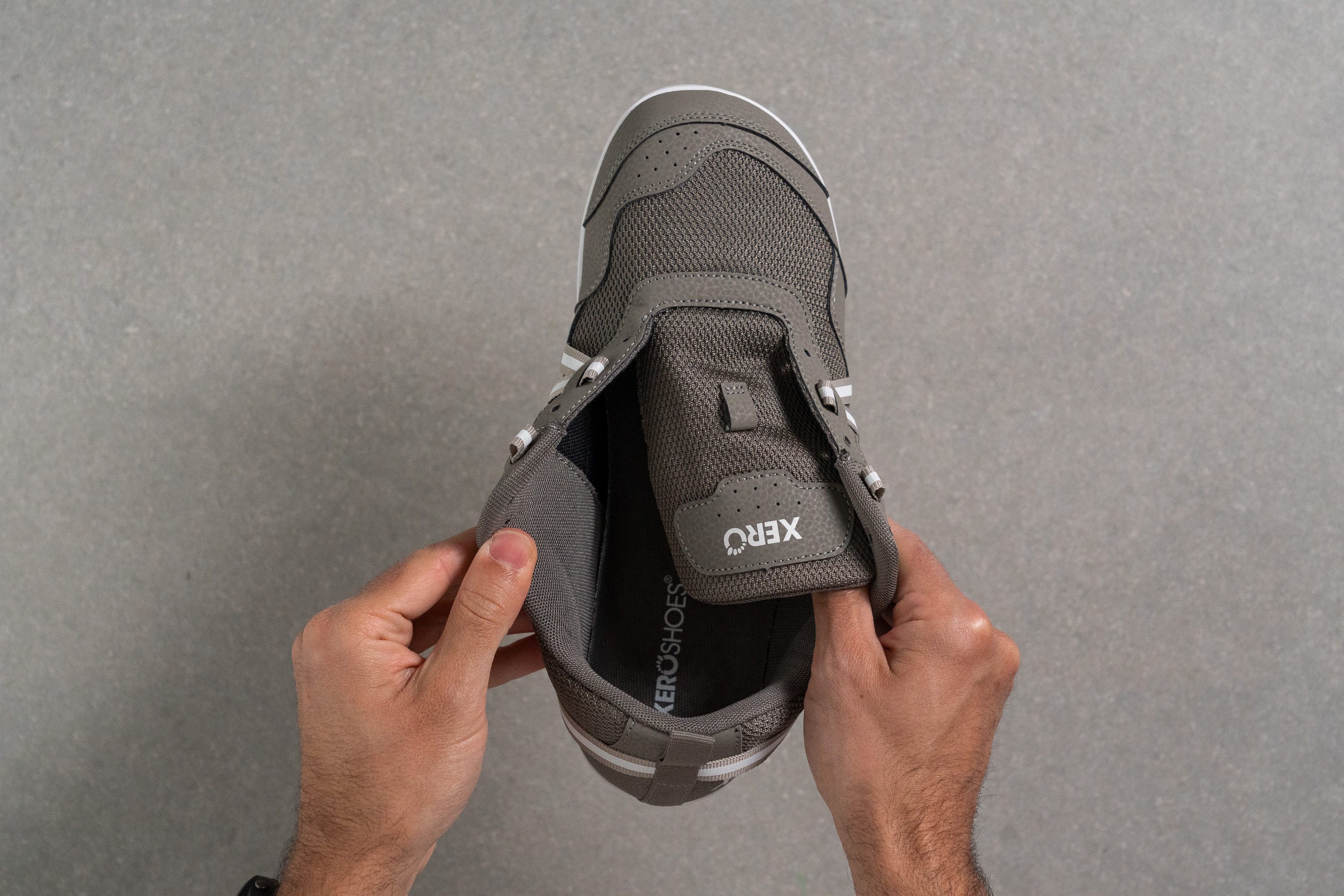
| Prio | None |
Price
The Prio comes with a super-competitive price tag—and that’s something worth applauding. With running shoe prices climbing in recent years, this model stays in the budget-friendly zone, making minimalist footwear more accessible to everyone.
| Prio | $90 |
| Average | $152 |
Heel tab
Unlike most other models from Xero Shoes that skip it altogether, the Prio includes a finger-loop heel tab.
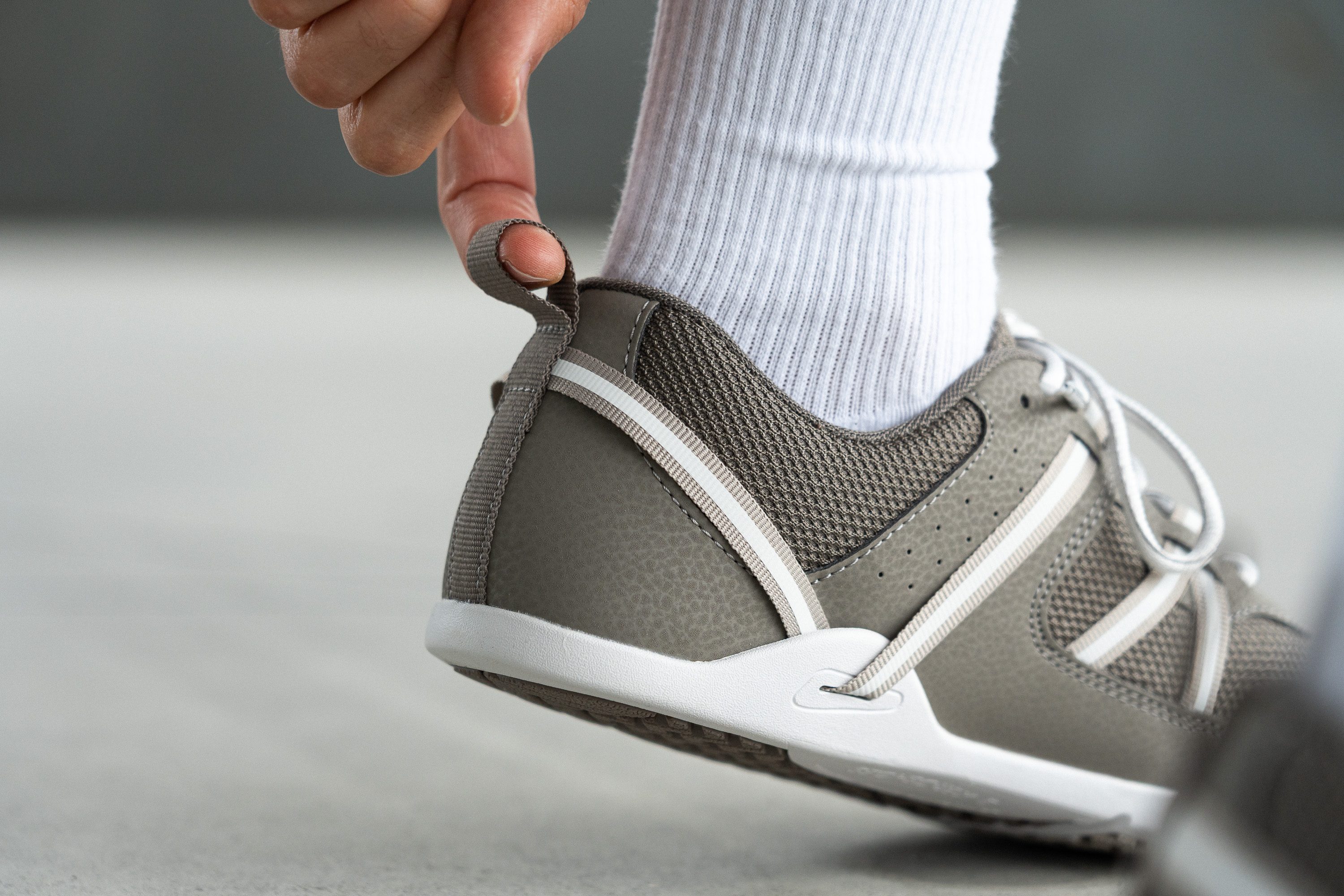
| Prio | Finger loop |
